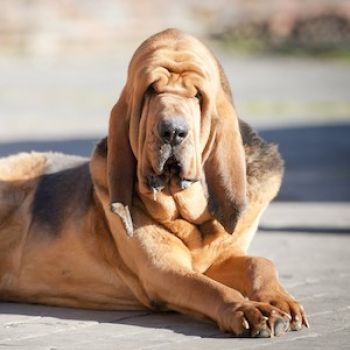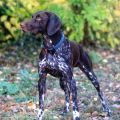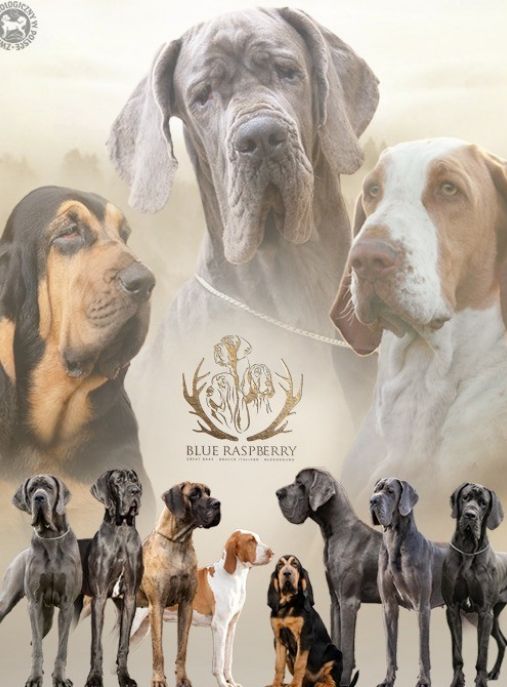The Bloodhound, also known as the St. Hubert Hound, is a remarkable breed that has captivated dog enthusiasts for centuries. With its distinctive droopy skin, long ears, and soulful eyes, the Bloodhound is instantly recognizable and has become an iconic symbol of tracking and scenting abilities. This breed is renowned for its exceptional olfactory senses, making it one of the most proficient tracking dogs in the world. In this comprehensive description, we will delve into the history, characteristics, and fascinating facts about the Bloodhound breed.
Originating from Belgium, the Bloodhound's history can be traced back to the medieval times. The breed's roots can be attributed to the St. Hubert Monastery in Belgium, where the monks selectively bred dogs with exceptional scenting abilities. These dogs were initially known as St. Hubert Hounds and were primarily used for tracking game during hunts. Over time, the breed's reputation spread across Europe, and they became highly sought after by nobility and royalty.
According to the FCI (Fédération Cynologique Internationale) typology, the Bloodhound belongs to Group 6: Scenthounds and Related Breeds. This group comprises various scent hounds that excel in tracking and trailing scents. The Bloodhound is classified under Section 1.1: Large-sized Hounds. This section includes other notable breeds such as the Basset Hound, the Grand Bleu de Gascogne, and the Otterhound.
Bloodhounds are primarily used for tracking and trailing scents, making them invaluable in search and rescue operations, as well as in law enforcement. Their exceptional scenting abilities allow them to follow a trail for miles, even if it is several days old. Due to their gentle nature and remarkable tracking skills, Bloodhounds are also popular as family pets and companions.
In terms of physical characteristics, the Bloodhound is a large and powerful breed. Males typically weigh between 90 to 110 pounds (41 to 50 kilograms), while females weigh slightly less, ranging from 80 to 100 pounds (36 to 45 kilograms). Their height at the shoulder can vary between 23 to 27 inches (58 to 69 centimeters) for males and 21 to 25 inches (53 to 64 centimeters) for females.
One of the most distinctive features of the Bloodhound is its loose and wrinkled skin, which hangs in folds around its face and body. This loose skin helps to trap and retain scent particles, enhancing the breed's scenting abilities. Additionally, Bloodhounds have long, pendulous ears that aid in capturing and directing scents towards their highly sensitive noses.
The breed's coat is short, dense, and weather-resistant, providing protection during outdoor activities. The most common coat colors for Bloodhounds are black and tan, liver and tan, or red. Some individuals may also exhibit a small amount of white on their chest, paws, or tail tip.
Bloodhounds have a relatively short lifespan compared to other breeds, typically ranging from 8 to 10 years. However, with proper care, nutrition, and regular exercise, some Bloodhounds have been known to live beyond 10 years. It is important to note that Bloodhounds are prone to certain health issues, including hip dysplasia, bloat, and ear infections. Regular veterinary check-ups and a balanced diet are essential to ensure their well-being.
Despite their large size, Bloodhounds are known for their gentle and affectionate nature. They are generally good with children and can be excellent family pets. However, their strong tracking instincts and powerful noses require a dedicated owner who can provide them with ample mental and physical stimulation. Bloodhounds thrive in environments that allow them to explore and engage their scenting abilities.
In conclusion, the Bloodhound is a remarkable breed with a rich history and exceptional scenting abilities. Their distinctive appearance, coupled with their gentle nature, makes them a beloved breed among dog enthusiasts worldwide. Whether serving as search and rescue dogs or loving family companions, Bloodhounds continue to leave an indelible mark with their unwavering dedication and remarkable olfactory senses.
The Bloodhound, with its distinctive droopy ears and wrinkled face, is a breed known for its exceptional character and unique personality traits. These dogs possess a gentle and affectionate nature, making them wonderful companions for families and individuals alike. In this text, we will delve into the character of Bloodhound dogs, exploring their behavior, how to raise them, and the best methods for training these intelligent and loyal canines.
Bloodhounds are renowned for their calm and patient demeanor. They are typically friendly and sociable, making them excellent with children and other pets. Their gentle nature extends to strangers as well, as they are generally welcoming and non-aggressive. However, their size and deep bark can be intimidating, making them excellent watchdogs.
These dogs have an incredible sense of smell, which is one of their most notable characteristics. Bloodhounds possess an olfactory system that is second to none, allowing them to track scents over great distances. This natural ability makes them exceptional search and rescue dogs, as well as valuable assets in law enforcement. It is important to note that their strong sense of smell can sometimes lead them to become easily distracted, so training and supervision are crucial.
When it comes to raising a Bloodhound, it is essential to provide them with plenty of mental and physical stimulation. These dogs have an innate desire to explore and follow scents, so regular exercise is vital to keep them happy and healthy. Long walks, hikes, and playtime in a securely fenced yard are all excellent ways to meet their exercise needs.
Bloodhounds are known to be independent thinkers, which can make training a bit challenging. They are intelligent dogs but can be stubborn at times. Patience, consistency, and positive reinforcement techniques are key when training a Bloodhound. Harsh or forceful methods are not recommended, as they can lead to a breakdown in trust and hinder the training process. Instead, focus on rewards, such as treats and praise, to motivate and encourage desired behaviors.
Socialization is another crucial aspect of raising a Bloodhound. Exposing them to various people, animals, and environments from a young age will help them develop into well-rounded and confident dogs. Puppy classes, obedience training, and regular outings to parks or pet-friendly establishments are all excellent ways to socialize your Bloodhound.
It is important to note that Bloodhounds are prone to certain health issues, including hip dysplasia, bloat, and ear infections. Regular veterinary check-ups, a balanced diet, and proper grooming are essential to ensure their well-being.
In conclusion, Bloodhounds are gentle, affectionate, and intelligent dogs with a remarkable sense of smell. They make excellent family pets, but their independent nature and strong scenting instincts require dedicated training and socialization. With the right approach, these loyal and loving canines will bring joy and companionship to any household.
The Bloodhound is a magnificent breed known for its exceptional tracking abilities and gentle nature. Caring for a Bloodhound requires a dedicated and responsible approach to ensure their well-being. Here is an extensive description of recommended care for Bloodhound dogs, including tips on what to do and what not to do.
1. Exercise: Bloodhounds are active dogs that require regular exercise to maintain their physical and mental health. Daily walks, playtime, and access to a secure, fenced yard are essential. However, avoid excessive exercise during their growth phase to prevent joint problems.
2. Grooming: Bloodhounds have a short, dense coat that requires minimal grooming. Regular brushing with a soft bristle brush will help remove loose hair and keep their coat healthy. Pay special attention to their ears, which are prone to infections, and clean them regularly to prevent wax buildup.
3. Nutrition: Provide a well-balanced diet that meets the nutritional needs of your Bloodhound. Consult with a veterinarian to determine the appropriate portion sizes and choose high-quality dog food that supports their growth and overall health. Avoid overfeeding, as Bloodhounds are prone to obesity.
4. Training and Socialization: Bloodhounds are intelligent but can be stubborn, so early training and socialization are crucial. Use positive reinforcement techniques, such as treats and praise, to motivate them. Enroll them in obedience classes to help them become well-behaved and sociable dogs.
5. Health Care: Regular veterinary check-ups are essential to monitor your Bloodhound's health. Vaccinations, parasite control, and dental care should be part of their routine. Bloodhounds are prone to certain health issues, including hip dysplasia, bloat, and skin infections, so be vigilant and seek prompt veterinary attention if any concerns arise.
6. Mental Stimulation: Bloodhounds have an excellent sense of smell and love using it. Engage their natural instincts by providing mental stimulation activities like scent games, puzzle toys, and nose work. This will keep them mentally sharp and prevent boredom.
7. Safety: Bloodhounds have a strong prey drive and an incredible sense of smell, which can lead them to wander off if not properly secured. Ensure your yard is securely fenced, and always keep them on a leash during walks. Microchipping and proper identification tags are essential in case they get lost.
What to avoid:
1. Harsh Training Methods: Bloodhounds respond best to positive reinforcement training techniques. Avoid using harsh or punitive methods, as it can damage their trust and hinder their progress.
2. Overfeeding: Bloodhounds have a tendency to overeat, leading to obesity and related health issues. Follow a strict feeding schedule and avoid giving excessive treats or table scraps.
3. Leaving Them Alone for Extended Periods: Bloodhounds are social animals and thrive on human companionship. Leaving them alone for long periods can lead to separation anxiety and destructive behavior. Ensure they have plenty of mental and physical stimulation, and consider doggy daycare or a pet sitter if you're away for extended periods.
4. Ignoring Ear Care: Bloodhounds are prone to ear infections due to their long, droopy ears. Regularly clean their ears and check for any signs of infection, such as redness, odor, or discharge.
5. Skipping Veterinary Check-ups: Regular veterinary check-ups are crucial for early detection and prevention of health issues. Skipping these check-ups can lead to undiagnosed problems and potentially worsen your Bloodhound's health.
By following these tips and providing the recommended care, you can ensure that your Bloodhound remains healthy, happy, and well-adjusted. Remember, a well-cared-for Bloodhound will reward you with unwavering loyalty and companionship for years to come.
The common color of Bloodhound dogs is a rich and deep shade of mahogany. This stunning hue is often described as a warm and earthy reddish-brown, reminiscent of the autumnal colors that grace the landscape during the fall season. The coat of a Bloodhound is characterized by its lustrous and glossy appearance, which further enhances the beauty of this unique color.
When observing a Bloodhound, one cannot help but be captivated by the intensity and vibrancy of their coat. The mahogany color is evenly distributed throughout their body, from the tip of their nose to the end of their tail. It is a color that exudes strength, elegance, and a touch of regality.
The mahogany coat of a Bloodhound is not a solid color, but rather a combination of various shades and tones that create a mesmerizing depth. In certain lighting conditions, the coat may appear darker, almost bordering on a deep chestnut brown. However, when the sunlight hits it just right, the mahogany color comes alive, revealing its true richness and warmth.
The texture of a Bloodhound's coat is another remarkable aspect. It is dense, short, and sleek, providing a smooth and velvety feel when touched. This luxurious texture enhances the overall appearance of the mahogany color, giving it a refined and polished look.
In addition to their mahogany coat, Bloodhounds often have distinct markings on their face and ears. These markings, known as "tan points," are typically a lighter shade of tan or reddish-brown. They can be found above the eyes, on the sides of the muzzle, and on the cheeks. These tan points add a touch of contrast and further accentuate the beauty of the mahogany color.
The color of a Bloodhound's coat not only contributes to their physical beauty but also reflects their temperament and personality. The deep and rich mahogany color is often associated with qualities such as strength, loyalty, and resilience. It symbolizes their noble lineage and their unwavering dedication to their duties as scent hounds.
In conclusion, the common color of Bloodhound dogs is a breathtaking shade of mahogany. This warm and earthy reddish-brown hue, with its depth and vibrancy, is a true testament to the beauty and elegance of this remarkable breed. The mahogany coat, combined with their distinctive tan markings, creates a visual masterpiece that perfectly complements the Bloodhound's regal and noble nature.
Bloodhounds are a magnificent breed known for their exceptional tracking abilities and gentle nature. However, like all dogs, they are prone to certain health issues that require careful attention and proactive care. Understanding the common diseases that affect Bloodhounds and implementing appropriate health measures can help ensure a long and happy life for these lovable canines.
One of the most prevalent health concerns in Bloodhounds is hip dysplasia. This condition occurs when the hip joint doesn't develop properly, leading to joint instability and subsequent arthritis. Regular exercise, maintaining a healthy weight, and avoiding excessive jumping or rough play can help reduce the risk of hip dysplasia. Additionally, providing a comfortable and supportive bed can alleviate pressure on the joints.
Another common ailment in Bloodhounds is bloat, also known as gastric dilatation-volvulus (GDV). Bloat is a life-threatening condition that occurs when the stomach fills with gas and twists on itself. To minimize the risk of bloat, it is recommended to feed Bloodhounds smaller meals throughout the day instead of one large meal. Avoiding exercise immediately before and after meals and using elevated feeding bowls can also be beneficial.
Bloodhounds are notorious for their droopy, long ears, which unfortunately make them prone to ear infections. Regular ear cleaning with a veterinarian-recommended solution can help prevent the buildup of wax and debris, reducing the likelihood of infections. It is crucial to dry the ears thoroughly after bathing or swimming to prevent moisture-related issues.
Additionally, Bloodhounds are susceptible to various eye problems, including entropion (inward rolling of the eyelids), ectropion (outward rolling of the eyelids), and cherry eye (prolapse of the third eyelid gland). Regular eye examinations by a veterinarian can help detect and address these issues early on. Keeping the eyes clean and free from irritants is also essential.
Due to their deep facial folds, Bloodhounds are prone to skin infections and dermatitis. Regular cleaning of the facial folds with a damp cloth and ensuring they are thoroughly dried afterward can help prevent bacterial or fungal growth. Using hypoallergenic shampoos and avoiding harsh chemicals can also promote healthy skin.
Maintaining a healthy weight is crucial for Bloodhounds to prevent strain on their joints and reduce the risk of obesity-related health issues. Providing a balanced diet that meets their nutritional needs, along with regular exercise, is essential. However, it is important to avoid excessive exercise during hot weather due to their predisposition to heat exhaustion.
Regular veterinary check-ups, including vaccinations, parasite prevention, and dental care, are vital for the overall health of Bloodhounds. Bloodhounds are also prone to certain genetic conditions, such as von Willebrand's disease (a bleeding disorder) and hypothyroidism. Genetic testing and early detection can help manage these conditions effectively.
In conclusion, while Bloodhounds are generally healthy dogs, they are predisposed to specific health issues that require diligent care. By being proactive in their health management, including regular exercise, proper nutrition, and routine veterinary care, Bloodhound owners can ensure their beloved companions lead happy and healthy lives.
The Bloodhound is a large and noble breed known for its exceptional tracking abilities and gentle nature. To ensure the overall health and well-being of these magnificent dogs, it is crucial to provide them with a balanced and nutritious diet. Proper nutrition plays a vital role in maintaining their energy levels, promoting strong bones and muscles, and supporting their immune system. In this text, we will delve into the nutritional requirements of Bloodhound dogs, offering advice on what and how to feed them, as well as highlighting foods to avoid.
Protein is an essential component of a Bloodhound's diet as it aids in muscle development and repair. High-quality animal-based proteins such as lean meats (chicken, turkey, beef) and fish are ideal choices. These proteins should make up around 20-30% of their daily caloric intake. It is important to avoid processed meats or those with excessive fat content, as they can lead to weight gain and other health issues.
Carbohydrates are another crucial aspect of a Bloodhound's diet, providing them with the necessary energy to support their active lifestyle. Opt for complex carbohydrates like whole grains (brown rice, oats) and vegetables (sweet potatoes, carrots, broccoli). These should constitute around 30-50% of their daily caloric intake. Avoid refined grains and sugary foods, as they offer little nutritional value and can lead to weight gain and dental problems.
Fats are an essential part of a Bloodhound's diet, providing them with a concentrated source of energy. Healthy fats, such as those found in fish oil, flaxseed, and olive oil, are beneficial for their skin and coat health. However, it is important to feed fats in moderation, as excessive amounts can lead to obesity. Fats should make up around 10-15% of their daily caloric intake.
Vitamins and minerals are vital for a Bloodhound's overall health and immune system function. While a balanced diet should provide most of these nutrients, it can be beneficial to supplement their diet with a high-quality dog multivitamin. Consult with a veterinarian to determine the appropriate dosage and specific needs of your Bloodhound.
When it comes to feeding Bloodhounds, it is important to establish a regular feeding schedule. Dividing their daily food intake into two or three meals can help prevent bloating, a condition to which they are prone. Additionally, providing fresh and clean water at all times is essential to keep them hydrated.
Avoid feeding your Bloodhound table scraps or human food, as it can lead to digestive issues and obesity. Certain foods are toxic to dogs and should be strictly avoided, including chocolate, grapes, raisins, onions, garlic, and anything containing xylitol (a sugar substitute). These foods can cause severe health problems or even be fatal to your beloved Bloodhound.
Lastly, it is crucial to monitor your Bloodhound's weight and adjust their food intake accordingly. Obesity can lead to various health issues, including joint problems and heart disease. Regular exercise, in combination with a balanced diet, will help maintain their weight and overall well-being.
In conclusion, providing a balanced and nutritious diet is essential for the health and longevity of Bloodhound dogs. A diet rich in high-quality proteins, complex carbohydrates, and healthy fats, along with appropriate vitamin and mineral supplementation, will support their active lifestyle and keep them in optimal condition. By avoiding harmful foods and maintaining a regular feeding schedule, you can ensure that your Bloodhound lives a long, healthy, and happy life.








